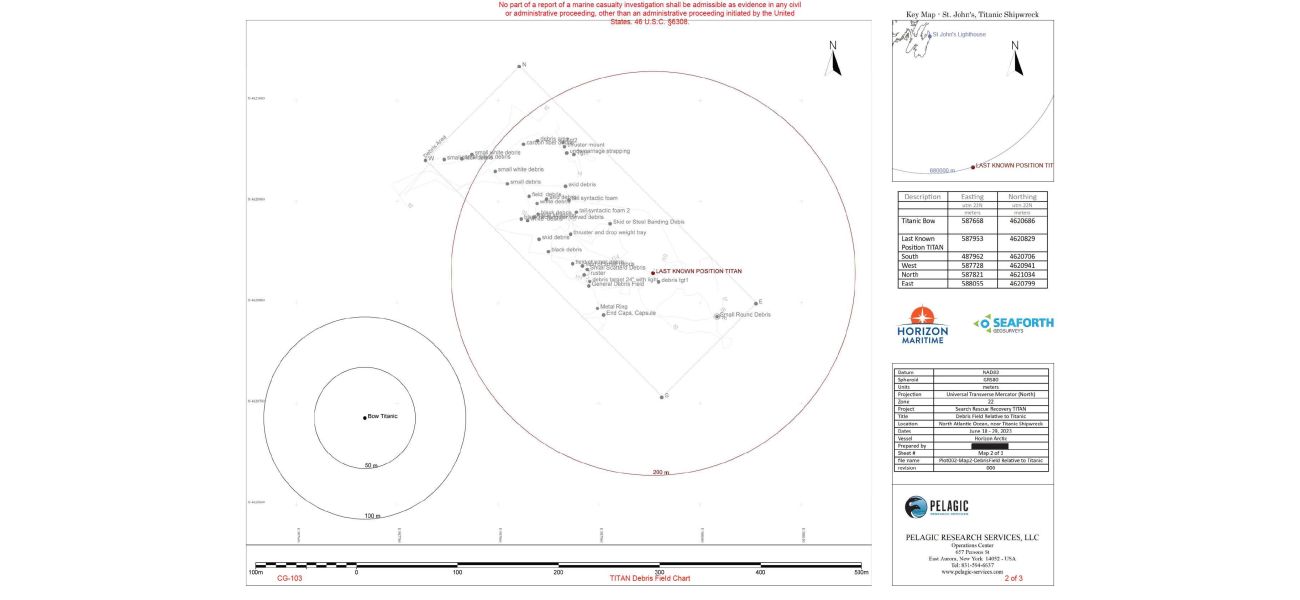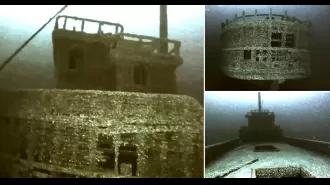Titan submarine came close to Titanic wreck before disaster, map reveals.
Large debris spread on ocean floor from sub's implosion during expedition to view famous shipwreck.
September 27th 2024.

The recent release of a new debris map by the US Coast Guard has shed light on the close proximity of the doomed Titan submarine to the Titanic when it met its tragic fate. The map reveals that the submarine was only a mere 1,600 feet away from the Titanic's bow before it imploded. The aftermath of the implosion resulted in a large field of scattered debris spanning over 322,917 square feet on the ocean floor. It is a stark reminder of the devastating consequences of the expedition to explore the famous shipwreck.
According to officials, some of the debris was found as close as 300m from the Titanic, adding to the gravity of the situation. The Coast Guard has been conducting salvage missions to collect as much wreckage and human remains as possible. However, the toll of the tragedy is already evident with the loss of five lives, including that of British adventurer Hamish Harding, father and son Shahzada and Suleman Dawood, and French national Paul-Henri Nargeolet. The nose of the Titan sub was also discovered on the sea floor, further highlighting the proximity of the two vessels.
The release of the new map has also raised questions about the safety and design of the submersible. Following the deaths, OceanGate, the company behind the expedition, suspended all operations. Former operations director David Lochridge expressed his hope that the concerns he had raised about the sub's safety were investigated by OSHA before the disaster. He believes that such a tragedy could have been prevented if proper measures were taken.
Multiple investigations are currently underway to determine the cause of the implosion in June 2023, but the timeline for their completion keeps getting pushed back. Eyos founding partner and expedition leader Rob McCallum stated that it is evident that the Titan "imploded," and attributed it to one or two faults in the amateur-designed vehicle. However, he refrained from speculating and pointed out the use of carbon fiber in the sub's construction as a major issue.
McCallum explained that carbon fiber is not a suitable material for deep-sea human-occupied vehicles and gets weaker with each dive due to micro cracks caused by stress and pressure. This revelation sheds light on a significant problem with the construction of the Titan sub and raises concerns about the safety of future ocean expeditions. As the investigations continue, the hope is that lessons will be learned from this tragedy to prevent similar incidents in the future.
According to officials, some of the debris was found as close as 300m from the Titanic, adding to the gravity of the situation. The Coast Guard has been conducting salvage missions to collect as much wreckage and human remains as possible. However, the toll of the tragedy is already evident with the loss of five lives, including that of British adventurer Hamish Harding, father and son Shahzada and Suleman Dawood, and French national Paul-Henri Nargeolet. The nose of the Titan sub was also discovered on the sea floor, further highlighting the proximity of the two vessels.
The release of the new map has also raised questions about the safety and design of the submersible. Following the deaths, OceanGate, the company behind the expedition, suspended all operations. Former operations director David Lochridge expressed his hope that the concerns he had raised about the sub's safety were investigated by OSHA before the disaster. He believes that such a tragedy could have been prevented if proper measures were taken.
Multiple investigations are currently underway to determine the cause of the implosion in June 2023, but the timeline for their completion keeps getting pushed back. Eyos founding partner and expedition leader Rob McCallum stated that it is evident that the Titan "imploded," and attributed it to one or two faults in the amateur-designed vehicle. However, he refrained from speculating and pointed out the use of carbon fiber in the sub's construction as a major issue.
McCallum explained that carbon fiber is not a suitable material for deep-sea human-occupied vehicles and gets weaker with each dive due to micro cracks caused by stress and pressure. This revelation sheds light on a significant problem with the construction of the Titan sub and raises concerns about the safety of future ocean expeditions. As the investigations continue, the hope is that lessons will be learned from this tragedy to prevent similar incidents in the future.
[This article has been trending online recently and has been generated with AI. Your feed is customized.]
[Generative AI is experimental.]
0
0
Submit Comment





